Radar Image Of The Surface Of Venus, Centered At 180 Degrees East Longitude. Magellan Imaging 1990-94

Radar Image of the surface of Venus, centered at 180 degrees east longitude. Magellan imaging 1990-94
via reddit
More Posts from Venusearthpassage and Others
Ten Interesting facts about Mercury
Mercury is the closest planet to the sun. As such, it circles the sun faster than all the other planets, which is why Romans named it after their swift-footed messenger god. He is the god of financial gain, commerce, eloquence, messages, communication (including divination), travelers, boundaries, luck, trickery and thieves; he also serves as the guide of souls to the underworld

Like Venus, Mercury orbits the Sun within Earth’s orbit as an inferior planet, and never exceeds 28° away from the Sun. When viewed from Earth, this proximity to the Sun means the planet can only be seen near the western or eastern horizon during the early evening or early morning. At this time it may appear as a bright star-like object, but is often far more difficult to observe than Venus. The planet telescopically displays the complete range of phases, similar to Venus and the Moon, as it moves in its inner orbit relative to Earth, which reoccurs over the so-called synodic period approximately every 116 days.

Mercury’s axis has the smallest tilt of any of the Solar System’s planets (about 1⁄30 degree). Its orbital eccentricity is the largest of all known planets in the Solar System; at perihelion, Mercury’s distance from the Sun is only about two-thirds (or 66%) of its distance at aphelion.

Its orbital period around the Sun of 87.97 days is the shortest of all the planets in the Solar System. A sidereal day (the period of rotation) lasts about 58.7 Earth days.

Mercury’s surface appears heavily cratered and is similar in appearance to the Moon’s, indicating that it has been geologically inactive for billions of years. Having almost no atmosphere to retain heat, it has surface temperatures that vary diurnally more than on any other planet in the Solar System, ranging from 100 K (−173 °C; −280 °F) at night to 700 K (427 °C; 800 °F) during the day across the equatorial regions. The polar regions are constantly below 180 K (−93 °C; −136 °F). The planet has no known natural satellites.

Unlike many other planets which “self-heal” through natural geological processes, the surface of Mercury is covered in craters. These are caused by numerous encounters with asteroids and comets. Most Mercurian craters are named after famous writers and artists. Any crater larger than 250 kilometres in diameter is referred to as a Basin.

The largest known crater is Caloris Basin, with a diameter of 1,550 km. The impact that created the Caloris Basin was so powerful that it caused lava eruptions and left a concentric ring over 2 km tall surrounding the impact crater.
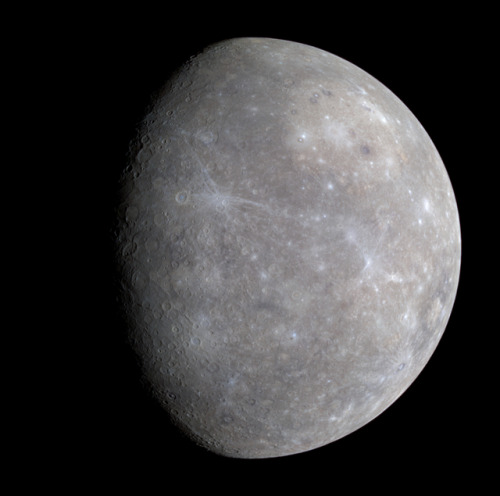
Two spacecraft have visited Mercury: Mariner 10 flew by in 1974 and 1975; and MESSENGER, launched in 2004, orbited Mercury over 4,000 times in four years before exhausting its fuel and crashing into the planet’s surface on April 30, 2015.

It is the smallest planet in the Solar System, with an equatorial radius of 2,439.7 kilometres (1,516.0 mi). Mercury is also smaller—albeit more massive—than the largestnatural satellites in the Solar System, Ganymede and Titan.

As if Mercury isn’t small enough, it not only shrank in its past but is continuing to shrink today. The tiny planet is made up of a single continental plate over a cooling iron core. As the core cools, it solidifies, reducing the planet’s volume and causing it to shrink. The process crumpled the surface, creating lobe-shaped scarps or cliffs, some hundreds of miles long and soaring up to a mile high, as well as Mercury’s “Great Valley,” which at about 620 miles long, 250 miles wide and 2 miles deep (1,000 by 400 by 3.2 km) is larger than Arizona’s famous Grand Canyon and deeper than the Great Rift Valley in East Africa.

The first telescopic observations of Mercury were made by Galileo in the early 17th century. Although he observed phases when he looked at Venus, his telescope was not powerful enough to see the phases of Mercury.
source 1
source 2
source 3
images: Joseph Brimacombe, NASA/JPL, Wikimedia Commons
Can u post pics of earth 🌍

The Blue Marble—Earth as seen by Apollo 17 in 1972
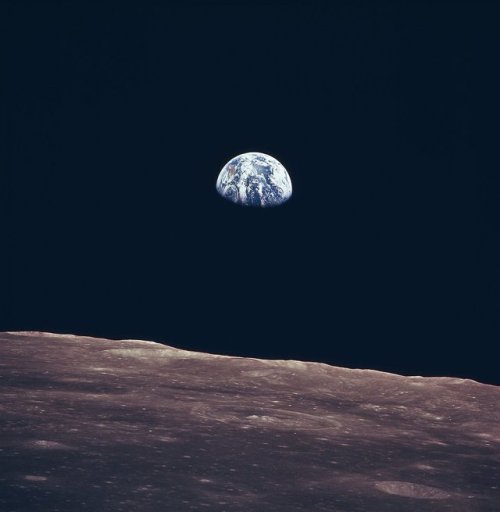
This incredible image of the Earth rise was taken during lunar orbit by the Apollo 11 mission crew in July of 1969. The first manned lunar mission, Apollo 11 launched aboard a Saturn V launch vehicle from the Kennedy Space Center, Florida on July 16, 1969 and safely returned to Earth on July 24, 1969.

This image taken by an astronaut aboard Space Shuttle mission STS-103 shows a panoramic view of Earth at moonrise.

In this rare image taken on July 19, 2013, the wide-angle camera on NASA’s Cassini spacecraft has captured Saturn’s rings and our planet Earth and its moon in the same frame.
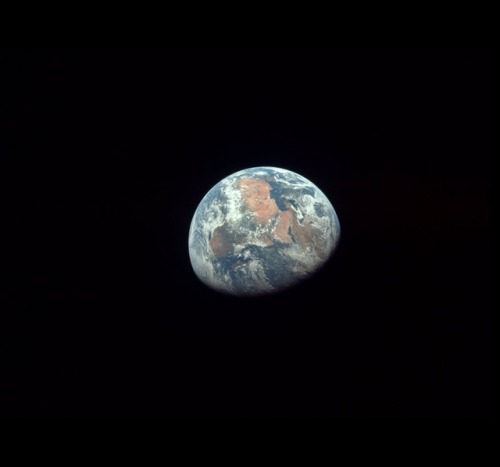
Earth as seen by Apollo 11 astronauts at the beginning of the third day of TLC

A view of the Apollo 11 lunar module “Eagle” as it returned from the surface of the moon to dock with the command module “Columbia”. A smooth mare area is visible on the Moon below and a half-illuminated Earth hangs over the horizon. The lunar module ascent stage was about 4 meters across. Command module pilot Michael Collins took this picture just before docking at 21:34:00 UT (5:34 p.m. EDT) 21 July 1969.

This panorama featuring Earth’s horizon and clouds over the South Pacific Ocean, complemented with a “tiny” distant moon (upper right), was photographed by one of the Expedition 36 crew members aboard the International Space Station.

The Sun from the Internation Space Station

images: NASA/JPL
To see more images and posts about the Earth click here.

NASA Study Proposes Airships & Cloud Cities for Venus Exploration
The surface of Venus isn’t going to work for humans, but what if we ignore the surface and stick to the clouds? Dale Arney and Chris Jones, from the Space Mission Analysis Branch of NASA’s Systems Analysis and Concepts Directorate at Langley Research Center, in Virginia, have been exploring that idea. Perhaps humans could ride through the upper atmosphere of Venus in a solar-powered airship. Arney and Jones propose that it may make sense to go to Venus before we ever send humans to Mars.
http://spectrum.ieee.org/aerospace/space-flight/nasa-study-proposes-airships-cloud-cities-for-venus-exploration

The 4 Terrestrial Planets
Daily Science Dump: Kepler’s First Law Edition
Bonjour my science nerds. I got a question regarding Kepler’s Three Laws because they can be somewhat confusing. And tbh, they really are. Because they can be a bit of a pain, I’ve decided to break this up into 3 sections, one for each law. They generally follow the same idea: planetary orbits are not circular. The difference between each law resides in the minute details. And because they are really detailed, I wanted to make sure I covered everything of each law so they don’t get confused. Let’s get started!
Kepler’s First Law of Planetary Motion
History
Before we get into the actual laws, we need to understand why these laws are so important. During the 1500s and early 1600s, astronomy was starting to become a big deal. We were trying to figure out where we are in the universe. During this time period, the famous geocentric and heliocentric models were stirring up massive controversy in the Catholic Church (for obvious reasons). Ptolemy brought around the geocentric model, which put Earth at the center. This was a natural thought at the time because it was a religious concept that man was God’s greatest creation, so God would want to put man at the center of everything (little presumptuous on our part tbh). Next, Copernicus said that our Sun was in the center, and all the planets orbit around the sun. This clearly didn’t go down well with the Church because it was the first instance of defying the Catholic Church, therefore defying God. In an attempt to settle down the controversy, Brahe brought around a new theory model, putting the Earth at the center, having the Sun and Moon orbiting the Earth, and then the rest of the planets orbiting the Sun. It was a very far reached model but people bought it. All of these models had one thing in common; all the orbits of the planets were circular. But none of none of the actual data fit with perfect circular orbits. This is where our boi Kepler comes in.

It was long believed that the planets should orbit along circular paths, because a circle is considered an ideal shape. But as I mentioned before, none of the data was fitting the circular shape, particularly Mars. Kepler brought around another shape, the ellipse, to explain the missing pieces of the data. An ellipse is like a flattened circle with some important properties that Kepler used for his laws. His first law focuses more on explaining the patterns of elliptical orbits. The second and third law goes into more detail on the properties of elliptical orbits.
If you’ve taken a simple geometry class, you know the basic principles of ellipses. We know there’s a major-axis and minor-axis (the diameter horizontally and the diameter vertically), the focal points, and eccentricity. All of these are important for planetary orbits. If we take a trip back to geometry, we know that the positions of the focal points affect the eccentricity, which is basically how much it’s being squished (if e = 0 then it’s a perfect circle and if e = 1 it’s a parabola).
All of this geometry going on transfers over into planetary motion. In this case, the Sun acts as one of the focal points. The other focal point is merely imaginary. Mathematically it exists but there’s nothing at that point in space that says “Hey! I’m a focal point for Saturn!”. But we know for sure that the Sun is on of the two focal points. This revelation caused a lot of uproar and many refused to believe it. Partly because the orbit of a lot planets are so close to a perfect circle it’s extremely hard to tell it’s elliptical at all.
Eccentricity has to stay between 0 and 1, like I explained earlier. An eccentricity of 0 is a perfect circle. If it’s 1 or greater, it’s a parabola. For the planetary motion, most of the planets’ eccentricity doesn’t even crack 0.1 (Pluto has a bit over 0.2 but apparently Pluto isn’t a planet #JusticeForPluto). Earth’s eccentricity is currently 0.0167, which means its very very close to a perfect circle. But not quite. To be quite honest, the fact that Kepler was able to figure out that the orbits were not circular is astonishing.
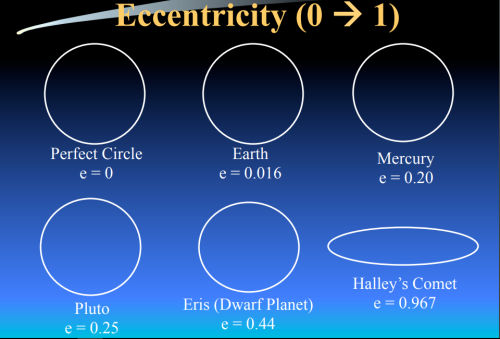
So that’s it for Kepler’s First Law of Planetary Motion! These laws were critical in understanding how our universe works and how our solar system plays out. It opened our eyes to many new ideas and thought processes. This law is just the first step of understanding the orbital tendencies of planets. On Friday, we will dive right into Kepler’s Second Law of Planetary Motion which goes into detail about the speed of the planet due to the elliptical orbit.
Don’t forget, I’m updating the Blog Website everyday with something new because I have no life…. I added cool space music! If you have any cool song recommendations for the playlist definitely shoot me a message!
If you have any questions about today’s Daily Science Dump or any past ones, don’t be afraid to ask!
As always,
Stay Nerdy!
R.L.
Solar System: Things to Know This Week
Go for Venus! Fifty-five years ago this week, Mariner 2, the first fully successful mission to explore another planet launched from Cape Canaveral in Florida. Here are 10 things to know about Mariner 2.
1. Interplanetary Cruise

On August 27, 1962, Mariner 2 launched on a three and a half month journey to Venus. The little spacecraft flew within 22,000 miles (about 35,000 kilometers) of the planet.
2. Quick Study

Mariner 2’s scan of Venus lasted only 42 minutes. And, like most of our visits to new places, the mission rewrote the books on what we know about Earth’s sister planet.
3. Hot Planet

The spacecraft showed that surface temperature on Venus was hot enough to melt lead: at least 797 degrees Fahrenheit (425 degrees Celsius) on both the day and night sides.
4. Continuous Clouds
The clouds that make Venus shine so bright in Earth’s skies are dozens of miles thick and permanent. It’s always cloudy on Venus, and the thick clouds trap heat - contributing to a runaway “greenhouse effect.”
5. Night Light

Those clouds are why Venus shines so brightly in Earth’s night sky. The clouds reflect and scatter sunlight, making Venus second only to our Moon in celestial brightness.
6. Under Pressure
Venus’ clouds also create crushing pressure. Mariner 2’s scan revealed pressure on the surface of Venus is equal to pressure thousands of feet under Earth’s deepest oceans.
7. Slow Turn
Mariner 2 found Venus rotates very slowly, and in the opposite direction of most planets in our solar system.
8. Space Travel Is Tough
Mariner 2 was a remarkable accomplishment, considering that in 1962 engineers were still in the very early stages of figuring out how operate spacecraft beyond Earth orbit. The first five interplanetary missions launched - by the U.S. and Soviet Union, the only two spacefaring nations at the time - were unsuccessful.
9. Not Ready for Its Close Up
Mariner 2 carried no cameras. The first close-up pictures of Venus came from NASA’s Mariner 10 in 1974.
10. Hot Shot

The first (and still incredibly rare) photo of the surface of Venus was taken by the Soviet Venera 9 lander, which survived for a little more than a minute under the crushing pressure and intense heat on the ground.
Make sure to follow us on Tumblr for your regular dose of space: http://nasa.tumblr.com

Computer Simulated Global View of Venus.
📷 NASA/Jet Propulsion Laboratory-Caltech
NASA considering cloud cities and air ships for manned mission to Venus
Cloud cities. On Venus. No, this is not the pitch for a potentially awesome science fiction story — this is a real-life proposal currently being considered by NASA.
Though Venus’s surface is far too volatile for us to visit anytime soon, scientists believe there’s a “sweet spot” in the Venusian atmosphere that would be the perfect place to fly some exploratory air ships and eventually establish a legit cloud city. Even better? They think it could be a whole lot easier than going to Mars. Well, kinda.
At approximately 31 miles above the planet’s surface, you’ll find one atmosphere of pressure and gravity just a tad lower than that of Earth. The average temperature, though admittedly hot, is just 17 degrees (Celsius) above the average Earth temperature. Hot, sure, but not unmanageable. Compare that to the wasteland of Mars, and it doesn’t sound too bad. Plus, since Venus is closer to the sun than Earth, that height is the perfect spot to tap into solar power — which could keep the ships (and cities?) running forever.
The Space Mission Analysis Branch of NASA’s Systems Analysis and Concepts Directorate at Langley Research Center is working on a proposal to send a robotic probe followed by manned air ships to the planet, leading to a permanent settlement. The five phases would include robotic exploration, a crewed mission to orbit on a 30-day mission, a crewed mission to the atmosphere on a 30-day mission, a crewed mission to the atmosphere for one year and finally a permanent human presence.
So, why might this be easier (in some ways) than a mission to Mars? The distance involved. A round-trip jaunt to Venus (440 days) would take almost half the travel time as a mission to Mars (650-900 days). But that doesn’t mean every aspect is easier. As IEEE Spectrum’s Evan Ackerman noted in a report that quotes NASA scientist Dale Arney, putting all the pieces together in motion above an alien planet wouldn’t be for the faint of heart:
The crewed mission would involve a Venus orbit rendezvous, where the airship itself (folded up inside a spacecraft) would be sent to Venus ahead of time. Humans would follow in a transit vehicle (based on NASA’s Deep Space Habitat), linking up with the airship in Venus orbit.
Since there’s no surface to land on, the “landing” would be extreme, to say the least. “Traditionally, say if you’re going to Mars, you talk about ‘entry, descent, and landing,’ or EDL,” explains Arney. “Obviously, in our case, ‘landing’ would represent a significant failure of the mission, so instead we have ‘entry, descent, and inflation,’ or EDI.” The airship would enter the Venusian atmosphere inside an aeroshell at 7,200 meters per second. Over the next seven minutes, the aeroshell would decelerate to 450 m/s, and it would deploy a parachute to slow itself down further. At this point, things get crazy. The aeroshell would drop away, and the airship would begin to unfurl and inflate itself, while still dropping through the atmosphere at 100 m/s. As the airship got larger, its lift and drag would both increase to the point where the parachute became redundant. The parachute would be jettisoned, the airship would fully inflate, and (if everything had gone as it’s supposed to), it would gently float to a stop at 50 km above Venus’s surface.
Considering the whole world is focused on Mars these days, even the team behind the proposal notes it’s unlikely for the focus to shift anytime soon. But the project is still a fascinating pitch. Seriously, can you even imagine a real-life Cloud City? Lando would be proud.
(Via io9, IEEE Spectrum)




Computer-generated image of the surface of Venus using radar data collected from the Magellan spacecraft [1024 × 1024]
-
 dreamilynoisyprince liked this · 5 years ago
dreamilynoisyprince liked this · 5 years ago -
 florida-lemons liked this · 6 years ago
florida-lemons liked this · 6 years ago -
 pomeowgranates reblogged this · 6 years ago
pomeowgranates reblogged this · 6 years ago -
 sophifi reblogged this · 6 years ago
sophifi reblogged this · 6 years ago -
 daydreambeeliever liked this · 7 years ago
daydreambeeliever liked this · 7 years ago -
 emerald-ccc reblogged this · 7 years ago
emerald-ccc reblogged this · 7 years ago -
 emerald-ccc reblogged this · 7 years ago
emerald-ccc reblogged this · 7 years ago -
 yasminnahra liked this · 8 years ago
yasminnahra liked this · 8 years ago -
 dewinkelvansinkel reblogged this · 8 years ago
dewinkelvansinkel reblogged this · 8 years ago -
 nidemp liked this · 9 years ago
nidemp liked this · 9 years ago -
 theirrelevanceofgender reblogged this · 9 years ago
theirrelevanceofgender reblogged this · 9 years ago -
 josemontt liked this · 9 years ago
josemontt liked this · 9 years ago -
 balehfileh-blog liked this · 9 years ago
balehfileh-blog liked this · 9 years ago -
 im-staying-calm-this-time liked this · 9 years ago
im-staying-calm-this-time liked this · 9 years ago -
 space-cigarettes reblogged this · 9 years ago
space-cigarettes reblogged this · 9 years ago -
 insanely-fancy-nebula reblogged this · 9 years ago
insanely-fancy-nebula reblogged this · 9 years ago -
 that-xenomorph reblogged this · 9 years ago
that-xenomorph reblogged this · 9 years ago -
 petitbot reblogged this · 9 years ago
petitbot reblogged this · 9 years ago -
 touchingwater reblogged this · 9 years ago
touchingwater reblogged this · 9 years ago -
 hoodoobarbie2 liked this · 9 years ago
hoodoobarbie2 liked this · 9 years ago -
 bunnyomo liked this · 9 years ago
bunnyomo liked this · 9 years ago -
 oqivy liked this · 9 years ago
oqivy liked this · 9 years ago -
 mini-space-alien-blog reblogged this · 9 years ago
mini-space-alien-blog reblogged this · 9 years ago -
 kayrazy-slideways reblogged this · 9 years ago
kayrazy-slideways reblogged this · 9 years ago -
 yungsedusaa reblogged this · 9 years ago
yungsedusaa reblogged this · 9 years ago -
 nightblush reblogged this · 9 years ago
nightblush reblogged this · 9 years ago -
 metalmanatee reblogged this · 9 years ago
metalmanatee reblogged this · 9 years ago -
 opedope-blog reblogged this · 9 years ago
opedope-blog reblogged this · 9 years ago -
 brownmessiah reblogged this · 9 years ago
brownmessiah reblogged this · 9 years ago -
 w0jt liked this · 9 years ago
w0jt liked this · 9 years ago -
 gloritas reblogged this · 9 years ago
gloritas reblogged this · 9 years ago -
 circuitdesign reblogged this · 9 years ago
circuitdesign reblogged this · 9 years ago -
 neverending-consciousness liked this · 9 years ago
neverending-consciousness liked this · 9 years ago -
 megliotordichemais liked this · 9 years ago
megliotordichemais liked this · 9 years ago